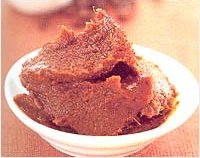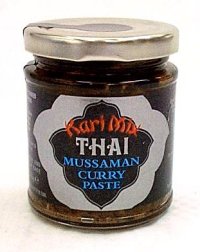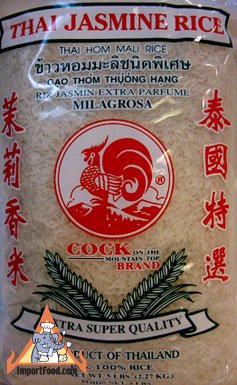We paid Sara Woodard, a native Thai despite her name, to come to a friend’s house and teach us several Thai dishes, in particular, ones we had eaten in restaurants. Not only did she succeed in teaching these to us, but they did not turn out, as often happens, to be pale imitations of what the restaurants serve. Instead, they were more flavorful and delicious than that. My requested dish was the Pad himapan or Cashew Stir-Fry.
Since that time, I’ve tried these dishes in several restaurants and modified them to suit ideas I’ve learned and liked, such as cooking the potato and yam for the Masaman curry separately instead of in the sauce for a nicer presentation.
General Notes...
...I have ferreted out.

First, a glossary: pad means “stir-fry,” himapan means “cashew” and ped means “hot.” Masaman (also spelled mussman and still other ways besides) is the Hindu word for “Muslim” and refers to the way Muslims cooked in India, at least as perceived by the Thai, and in what way what they cooked was later imported to Thailand.
The Pad himapan makes enough for up to 3 medium servings while the other two make up 2-4 servings at most. They are all served with steamed white rice. In general, count on ¼ to ½ pounds of meat per person (depending on what else and how much you are serving) and multiply these recipes accordingly.

Sara measures each time instead of eyeballs the small ingredients. She say she does this for consistency, so that her dishes have the same flavor every time.
To the right, here, we see some masaman curry paste and the store-bought bottle. Usually it’s darker than this; the other pastes have a similar appearance.
“Thin” soy sauce is not watered-down Kikkoman or normal soy sauce. It must be purchased from your local Asian market. Similarly, the other special preparations (sweet chili paste, masaman curry paste and red curry paste) must be purchased. Like Indian curry, they cannot be easily manufactured, but unlike Indian curry, the ones you get at the Asian market are quite satisfactory obviating the need for an advanced degree in Chemistry. You may have to purchase coconut milk at the special market, but the rest of the ingredients can be had in any grocery store. Coconut milk in cans keeps for a long time: purchase a whole case; it can also be mixed into limeade and shaved ice to make piña colada.
I make a Jasmine rice in a cooker. For each cup of rice, add 1½ cups water. There is no need to rinse. Japanese Nishiki sticky rice is good, but if you’ve eaten Thai food in a cestaurant, you’ve probably eaten Jasmine rice and anything else won’t taste quite right. Plan on 1 cup of rice uncooked for every 2 to 3 servings.
However, if you have the time and presence of mind, pre-soak your rice for 30 minutes. Soaking rice speeds up the cooking by kick-starting the absorption of water before the rice even enters the pot. By letting rice soak for 30 minutes or so, you can reduce the cooking time of most rice varieties by about 20 percent.
Acetylpyrroline, the flavor component in aromatic rice varieties (such as jasmine or basmati) that is mainly responsible for their characteristic aroma, dissipates during cooking. The longer rice is over the heat, the less aromatic it will be. So by soaking the rice and shortening the cooking time, you get more flavorful results.
Make certain you know your rice cooker, how long the quantity of rice you want to serve takes to cook, then back up before your preparation so that this is done and ready to serve as soon as your dish is. Stir-fries and curries lose their decorative appearance and in many ways their textures if they sit too long on or off the stove.
Additional notes from Sara
- - For coconut milk, purchase Mae Ploy brand for best taste
and not too much water.
- - For curry paste, purchase Mae Ploy brand.
- - For sauce use “thin soy sauce” made by Kwong Hung Seng Sauce (Dragonfly brand).
- - For chili paste, purchase “Chili Paste with Soya Bean Oil” made by Pantai.
- - Recommends purchasing Thai ingredients at Thai market on 3rd South in Provo next to Thai Pepper Restaurant.
- - For curry paste, purchase Mae Ploy brand.

